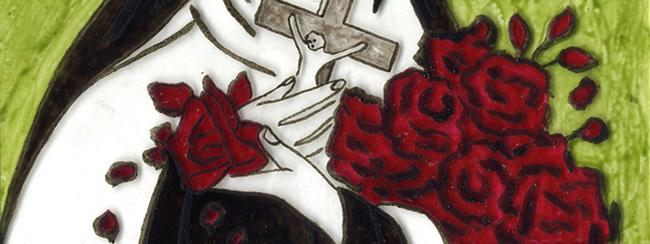A one-of-a-kind collection of miracles: The RAINS of ROSES
Read the coverage analysis here

The Rain of Roses is a one-of-a-kind collection of miracle stories. Published between 1907 and 1926, in 10 volumes including 7 chronological, 2 thematic and an anthology, it presents more than 3200 testimonies of graces and healings obtained through the intercession of Sister Thérèse of the Child Jesus, before her canonization.
These stories cannot be compared to the few dozen miracles recognized in Lourdes, or to the few miracles recognized by Rome during the canonization of a saint. Rather, they should be read as testimonies of thanksgiving, since they are written by the recipients or witnesses of the grace received, and listed in chronological order, with the aim of showing that the Rain of Roses wins each year in intensity, as Thérèse's notoriety spread. They take place, in fact, within the framework of the process of canonization of Thérèse, prepared from 1907, opened in 1910 and closed in 1925. This procedure indeed imposed on its defenders to prove the reputation of holiness of Thérèse, and the accounts of miracles sent to the Carmel of Lisieux have been carefully preserved for this purpose. The edition of the Rain of Roses responds to the same imperative.
The published accounts are therefore accounts received in Lisieux, and published after a summary investigation, in order to establish the maintenance of the pardon obtained, and also that the witnesses and actors are worthy of faith. The final document is published after formal corrections, and with the authorization of the beneficiaries of the grace, who have sometimes requested anonymity. Such a mass aimed to show Thérèse's qualities as an intercessor and, consequently, the excellence of her "little way" and the sanctity of her life: the Rain of Roses is intimately linked to the dynamics of trust lived and taught by Therese. It also aimed to encourage the prayer of intercession, endeavoring to present, in each volume, a complete range of all the physical, spiritual, moral and material evils relieved by the little saint, without neglecting the evocation of extraordinary phenomena. such as apparitions or perfumes. In the eyes of the Carmelites of Lisieux, the Rain of Roses is a particularly effective gateway to introduce spirituality and the Teresian figure.
Today, we can say that this series of stories is astonishing more for the editorial phenomenon that it represented than for the mass of stories collected in Lisieux: the sanctuaries or the saints credited with thousands, even tens of thousands of post-mortem answers are not so rare, while the Rain of Roses – that is to say this publication in the annals – and the success it has met with are quite singular. This type of publication, moreover, did not meet with unanimity: the Rain of Roses was interrupted by Rome when the Cause was introduced in 1914. During this interruption, numerous typewritten booklets, relating the Interventions of Sister Thérèse of the Child Jesus during the war circulated in hospitals, military chaplaincies, trenches, but also in the rear, so much so that Rome had to authorize the resumption of miraculous annals.
One can estimate at around 8 the accounts of miracles recorded in the Carmel of Lisieux between 000 – date of publication of the Story of a Soul – and 1898, date of canonization. This is counting without the graces evoked briefly or evasively in the course of the considerable correspondence sent to Lisieux during all these years. Without counting, either, the graces received which have not been reported to the Carmel.
The first "Rain of Roses" was published at the beginning of 1910, under the title Some of the graces and healings attributed to the intercession of Sister Thérèse of the Child Jesus who died in the odor of sanctity in the Carmel of Lisieux. , 1873-1897. - “Rain of roses”. The title page highlights already famous formulas on which the prayer of intercession is based:
“I want to spend my heaven doing good on earth”
“After my death, I will make a shower of roses fall”
This small work was first published in 8 copies and then went through successive reissues, augmented under the promising title of Rain of Roses I. Already, in the 000 edition of the Story of a Soul, a long note to the end of the book mentioned the benefits dispensed by Thérèse. Here it is in full:
“I WANT TO SPEND MY HEAVEN DOING GOOD ON EARTH... AFTER MY DEATH, I WILL SEND A RAIN OF ROSES. »
These gracious promises, Sister Thérèse of the Child Jesus realizes them fully, in a touching and truly prodigious way. Since the publication of his “History”—already translated into five languages—we continue to receive from all quarters the most precious testimonies. It is sometimes the cure, the relief of a sick person; it is, more often, the cure, the relief, the consolation of a soul. People come from afar to kneel on the tomb of this chosen one of God. Priests, young missionaries leaving for the Far East have respectfully kissed this blessed land, taking away flowers like veritable relics. We are not enough to satisfy the pious desires of all those who ask for a souvenir of the “little queen”, of the “little Saint Thérèse”, of the little great saint”, of the “little flower”. This is how everyone takes pleasure in diversifying the titles of the woman who caused venerable priests and eminent religious to write:
“Sister Thérèse of the Child Jesus is a providential soul, her divine mission is obvious. »
“This dear little saint is now a remarkable missionary, with a powerful and irresistible word; she thus brilliantly keeps her promise to "spend her heaven doing good on earth." »
“The life of this self-written soul has a charm that will never be lost, and any soul that falls into this hook will not remain in lukewarm waters or sinful waters. »
“I can affirm to you that the Lord works beautiful and great things by means of your little saint; here, in our seminary, it transforms souls. »
“Séraphin, she was so in face and soul, and one can say of her what Saint Bonaventure says of Saint Francis: THAT SHE WAS ENTIRELY A BLAZING COAL. “Divine love is fire and flame, the Song of Songs tells us, and Jesus, substantial love, declares THAT HE CAME TO THROW THIS FIRE ON THE EARTH AND WANTS IT TO IGNITE. The heart of Sister Thérèse is a very ardent brand, a pure flame of Paradise, which has kindled and will kindle many other hearts. And with what force, and at the same time what sweetness! »
“We can say of her, with a small change in the sacred text: SHE LEADS US, AND WE RUN TO THE SMELL OF HER PERFUMES. Her perfumes are her humility, her purity, her love for her God, so tender, so abandoned, so ardent! Happy victim who was not only consumed by the fire and the flames of divine love, but also received the beautiful gift of communicating them powerfully to souls. The Lives of the Saints tell us about these fires of divine love, the life of Sister Thérèse makes us see and feel them; the others make us want to love God, but this one sets the soul on fire. »
Poetry too, by a just return, came to lay flowers on the tomb of Sister Thérèse of the Child Jesus. Let us quote only this graceful sonnet:
Joan of Arc and Sister Thérèse of the Child Jesus
Lisieux, sister of Rouen who burned the Maid,
Your Carmel perfumed with the flower of virtues
Songs still resound only to the chaste Immortal
Lavish without counting SISTER OF THE CHILD JESUS.
If Jeanne, obeying the voice of the elect,
By the sword saved his motherland,
Therese has prayer in her hands, and her sweet zeal
To the eternal kingdom return those he has lost.
But which is the greatest and which is the purest?
Which bears the holiest wound in the heart?
Which is more loving and more martyr finally?
O the two virgin sisters, thus consumed you,
Almost in the same place, two bonfires that were lit.
One hellish hatred, the other divine love.
A. JEANNIARD DU DOT. Nantes, December 9, 1900.
O you who loved Jesus and souls so much, you who said to us on your deathbed: "I have never given God anything but love, He will return love to me...", your word was a prophecy. Yes, we are the happy witnesses of this, the Lord returns love to you! Thousands of hearts, which formerly were unknown to you, today venerate and love you. They do more: they call with their wishes and their prayers for the day when the Holy Church as a whole will honor your blessed memory... and on all her children your rain of roses." Source: Story of a Soul, 1901, p. 483-486.
In 1907, a decisive date in the history of the Story of a Soul, this note was replaced by 60 pages of accounts of miracles: this was to be the matrix of Pluie de Roses I. And when the separate edition of the Rain of Roses, one will continue to find this supplement in the History of a soul until 1914 then, thereafter, an anthology a little less copious, but containing accounts more detailed, more striking and better documented: in the eyes of the Carmelites from Lisieux, the Rain of Roses is an integral part of Sister Thérèse's life.
This publication of stories of graces independently of the story of a "servant of God" to whom they are attributed seems unprecedented at this time, even if Catholics have been accustomed to the modern miracle by the considerable and enduring success of publications on the miracles of Lourdes.
Each volume of Rain of Roses has its own history and constitution, depending on the context of its writing (the stages of the canonization process) and depending on the nuns in charge of its elaboration.
La Pluie de Roses also had several versions on glass plates, for projection sessions! And also an illustrated version, an anthology summarizing the Rain of Roses after publication ceased in the annals, and is included in widely distributed booklets such as Sister Thérèse of the Child Jesus. His life. Since his death (Bar-le-Duc, 1913; multiple reissues, 60 p., with illustrations). The second part "Since his death" highlights the highlights of posthumous life, around stories of miracles and the steady pace of the canonization process.
The promotion of Thérèse thaumaturge, however, was not done only by the publications of the Carmel. First, because the stories published highlight the importance of word of mouth in the development of this reputation, and the desire of everyone to make known the graces received. Then because the Catholic press, general or specialized, has widely echoed the "Thérèse phenomenon", including by publishing accounts of miracles, or weekly sections of thanksgiving to Sister Thérèse (La Croix, the Annals of the Propagation of the Faith or The Messenger of the Heart of Jesus).
The Rain of Roses is therefore only the most visible part of the Teresian miraculous phenomenon today. Carmel publications constantly and intimately link miracles, the life of Sister Thérèse and doctrine, and these three elements constitute three facets of the Teresian phenomenon. Each refers to the other two: life as a prophecy of the future role played on earth and as a stimulus for the reader's own life, and miracles as proof of the authenticity of his life and the effectiveness of his thought on the level of the Hi.
The omnipresence of miracles shows enough that they are not anecdotal: to show the proliferation of the supernatural around Thérèse is to show the particular effectiveness of Thérèse's teaching and contribute to hastening her canonization.
Antoinette Guise


